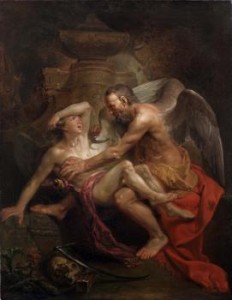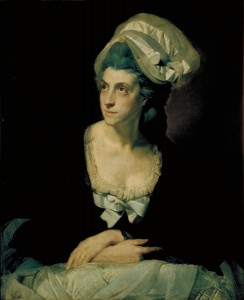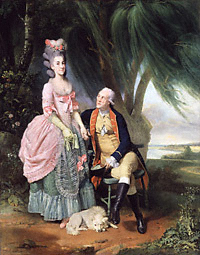
Professor Johan Zoffany RA: Society Observed
@Royal Academy of Arts, Green Park Tube, London https://www.royalacademy.org.uk/exhibitions/johan-zoffany-ra-society-observed/
10 March—10 June 2012
Tickets: 10.50 adults, 6.50 concessions
Having never heard of Zoffany (I am now ashamed to say) I was surprised to see the exhibition. Held in the RA’s sackler wings it forms a retrospective reevaluation of the work of Johan Zoffany. Born Johannes Josephus Zauffaly in Frankfurt of 1733 he later Anglicised his name. One of the reasons why Zoffany has been relegated and partially ‘written out’ of RA history was his German birth, another was his refusal submit to the Royal Academy election process, leading the King to personally appoint Zoffany RA. His reputation also suffered by the attribution of lesser works to him, for unclear reasons (although Xenophobia may have played its part).

When I walked into the exhibition I had this feeling it was going to be another of those something and nothing old fashioned portraiture events, but I was wrong. There is a wonderful sense of humour that runs through Zoffany’s work. The first work I came to that started to hint at more than your average was “The clipping of the Wings of Love”, 1761, oil on canvas, a lovely little number which sadly reproduces terribly due to painterly nature. This is a painting to be seen in the flesh! Zoffany’s theatre paintings resulted from his close friendship with Garrick, and in these, notably the prints we see the influence of Hoggath and the sense of staging. The paintings read like scenes from a play, and were designed with reproduction and decoration in mind, almost like advertisements.
Throughout the prints and pencil works show a more relaxed style, with none of the stiffness that seems to creep into Zoffany’s theatrical works. After the theatre section the exhibition moves through the anatomical drawings with a fabulous anonymous sculpture on display, revealing the skeletal and muscular structure. Then, we move into what has to be the beginning of the fun part!
The informal quality of Zoffany’s work marks it out from the usual over styled Georgian portraiture. He became renowned for his portrayal of the domestic qualities, the Queen as mother, John Wilkes with his jacket buttons undone, and children at play. There is a certain inconsistency in many of the works, and Waterhouse’s branding of Zoffany as “a lazy painter” sometimes seems valid. An exquisitely rendered figure will be placed in a background that looks a little half baked, and careful detailing seems to be lost to slapdash continuations. The quirky humour struck me upon entering the room with
“John Wilkes and his Daughter Mary (Polly)” 1779 and “The Sharp Family”, 1779-81, oil on canvas, 115.6×125.7 cm. Look at the dog!

From that moment the rest of the exhibition was not only art appreciation but a game of ‘Where’s Wally?’ or in this case ‘Where’s the reoccurring motif?’. The little dog only seemed to make those two appearances (please let me know if he is spotted again!) but an egg timer, curtains, left foot and certain laces and fabrics seemed to appear as props with an amusing regularity. “La Scartocciata” 1778 is a wonderful, vibrant musical scene, complete with two left feet! The most tender and informal portrait of the exhibition was “Mary Thomas (Mrs Zoffany)”, c.1781, oil on canvas, 75 x 61.5cm, Ashmolean Museum. Showing the artist’s pregnant teenage mistress who he married in a bigamous ceremony, there is a clear feeling of connection and love.

The artist’s life is certainly of as much interest as his works, notably the bizarre marital status. Zoffany’s first wife, whom he married in haste in 1769 was abruptly sent back to Germany within a year, from the time of their separation he considered himself a single man. In order to pass Mary Thomas off as his wife Zoffany married her abroad in first a Catholic then a Protestant ceremony, having told her his wife was dead. The wonder of the romance was that having discovered his deception she accepted it and they lived quite happily. Partially because of the ‘marriage’ abroad and the popularity of the couple in Florence when they returned to England in 1779 the family were accepted.
- Zoffany painted for English royalty and European aristocracy. Amongst his,many honours he was awarded a Baron of the Holy Roman Empire by Empress Maria Theresa in 1776, in recognition of his wonderful portraits. Describing himself as a gypsy, Zoffany travelled throughout India, Austria, Germany, England and Italy. In the room dedicated to his time in India are two wonderfully atmospheric paintings of India showing “Nagapon Ghut” and “Dahlia”, one by fire and moonlight, the other in bright sunshine. These were my favourite pieces of the exhibition, saving the portrait of Mary Thomas. The influence of travel, colour and cultures shows through the work and gives it a extra lift.
The exhibition ends with Zoffany’s final self-portrait, showing a man loosing his way to dementia but still in possession of highly developed painterly skills. A very funny, touching and quirky exhibition.


Leave a Reply